
The church of St. Demetrios, patron saint of Thessaloniki
The church of Saint Great-martyr Demetrios the Myrrh-gusher, patron of Thessaloniki, was built in the early 5th century AD by Leontius, the prefect of Illyricum, over the Saint’s tomb. Saint Demetrios held the military office of proconsul during the reign of emperor Diocletian in the early 4th century; he was martyred as a Christian by imperial decree, after the defeat of wrestler Lyaeus in the city’s stadium by Nestor, a disciple of Demetrius.
A great fire between the years 629 and 639 destroyed large part of the Church. Pious Thessalonian people, headed by their bishop John, rebuilt and expanded it. In 904 the church was raided by Saracens and the saint’s holy relic was partly seized. A similar depredation by the Normans took place in 1181, when the city was captured by them.
In 1493, the Turks turned the church into a mosque. The saint’s cenotaph was moved to the western side of the church, secluded from the rest of the mosque. After the liberation of Thessaloniki in 1912, the Church reopened as a place of Saint Demetrios’s veneration. The conflagration of 5 & 6 August 1917 burnt the two thirds of the city, while the historical church, which for 15 consecutive centuries had been the jewel and pride of the Hellenic nations’s co-reigning city, was mostly turned into ruins. The restoration works that followed returned the church into its initial impressive form.
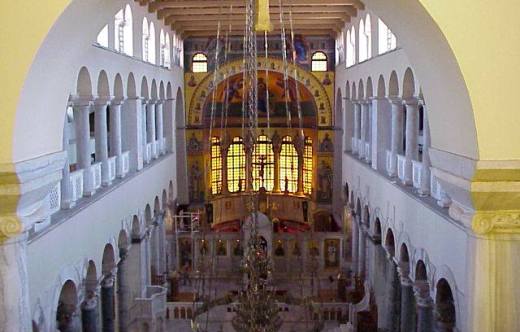
As a matter of art, Saint Demetrios Holy Pilgrimage Church is one of the most magnificent Greek Christian monuments. Its architecture saved the most authentic type of early Byzantine basilica, or dromic church, with a wooden roof. It has a transverse aisle in front of the sanctuary, and galleries over all other aisles and the narthex. Its current form is that of the 7th century and constitutes one of the most significant martyr church. In terms of city planning, it lies in the center of the old town, to the northeast of the Ancient Agora. Its top view dimensions are 43,58 m. length and 33 m. width. Four colonnades divide it into five aisles or stoas. The middle aisle is wider than the other four and is separated from them by eight green and twelve white columns, as well as four pillars that are adorned with capitals crowned by volutes. The walls and the pillars are coated with colorful slabs, which make up the revetment of the elevated central aisle. The lateral aisles are sheltered with escalating roofs, so that unilobed, bilobed and trilobed windows are created to bring ample light into the majestic interior of the basilica. Over the lateral aisles, spacious galleries have been constructed.

Around 1481, the marble Renaissance-style tomb of Loukas Spandounes was embedded into the left colonnade, next to the narthex, below which a thirteen-rowed inscription has been saved to this day, constituting a praise for the Thessalonian noble. Spandounes had been paying a heaviest duty to the Turks, since the day they conquered Thessaloniki, in order for the Church to be kept in possession of the city’s faithful.
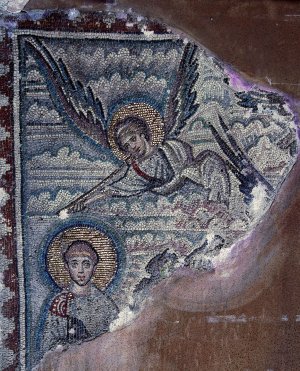
The splendor of Saint Demetrios church is not only expressed in its truly stellar architecture. The colorful revetment and the rich sculptural decoration lend a unique, timeless and monumental value to the work of the church’s construction and embellishment. The iconographic decoration of the basilica, consisting of mosaics and paintings, make the church even more imposing, since this decoration is represented by works of various periods and phases of Byzantine art.
In the original sources, Saint Demetrios is called a “Great-martyr”, “City-lover”, “City-savior”, and “Myrrh-gusher”. He has been named a Myrrh-gusher, because he poured forth myrrh from his tomb, which was taken up by the faithful in flasks made from glass, clay, or lead, called “coutroubia”. The myrrh of the Saint is a miracle of God and a remarkable blessing of the Great-martyr to the faithful Christians who call upon his sleepless intercessions. There are many witnesses to the myrrh of Saint Demetrios and those who receive the blessing of the myrrh receive get grace from God to this day.
The urn of Saint Demetrios’s relics

In the middle of the church, near the left colonnade, there has been for centuries a sepulcher, where lies the silver urn with Saint Demetrios’s grace-conveying relics, which are a source of blessing, miracles and beneficence not only for the pious Thessalonians, but also for all those who come as a pilgrim to venerate Saint Great-martyr Demetrios the Myrrh-gusher.
The Tomb Chapel
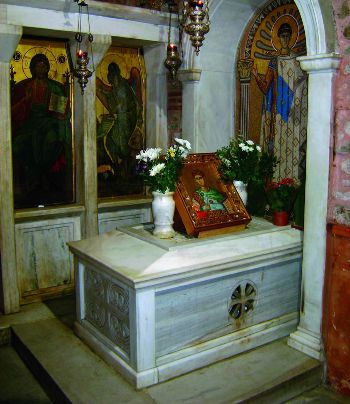
Next to the urn, on the church’s left side, lies the so-called “tomb chapel” of Saint Demetrios. This was initially a building of old Roman public baths. When the church was turned into a mosque, the Saint’s tomb was moved into this chapel from the sactuary, where it previously lay.
The Holy Well
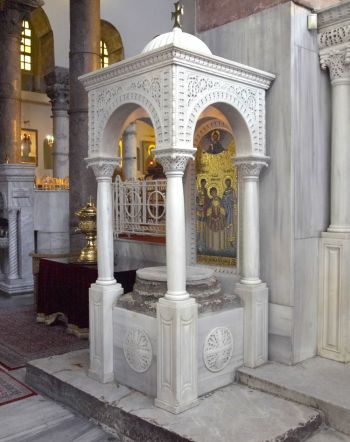
It is located in front of the left pillar of the sanctuary embellished with a marble funerary monument. This has been the first tomb of Saint Demetrios, because the pagans threw his body in it to be destroyed and vanished. This well provided water for the roman baths. It was from this place that the priests later distributed well water and myrrh to the faithful.
The Crypt
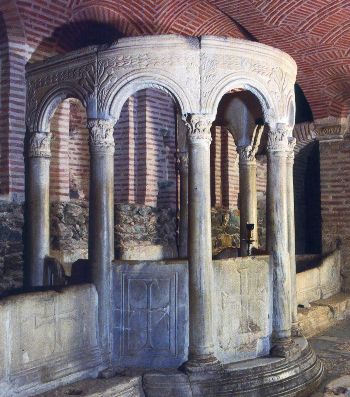
The entrance of the crypt is located next to the right pillar of the sanctuary and leads to the basement of the church, which is the place where Saint Demetrios is traditionally thought to have been imprisoned, martyred and buried. It is the left side of a big Roman bath that operated near the Agora and the Stadium for the convenience of athletes.
In the 5th century, after the establishment of the first big church, the bath chambers were incorporated into the existing building as the place of martyrdom and crypt. Initially, the Thessalonian faithful honored the Saint in the crypt through the well water that they received from the fountain flowing out of a well that remains to this day. After the 10th century, the fountain was connected with the myrrh to be collected by the faithful.
The churchyard
Before the 1917 conflagration, there were a gate and remnants of the ancient stadium in the frontal yard, on the western side of the church. Today the only thing remaining is the large circular marble bowl of the holy water font.
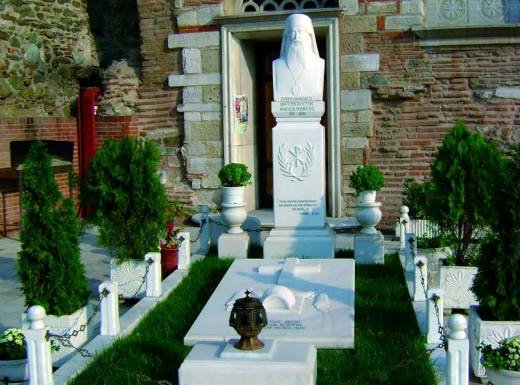
In the courtyard, there also lies the tomb and the bust of late Metropolitan Panteleimon II of Thessaloniki (1925 – 2003), who during his reign brought Saint Demetrios’s holy relics back to Thessaloniki from Italy, where they had been for centuries.
Saint Demetrios’s Life and Martyrdom
Saint Demetrios was born around AD 280-284 and martyred in AD 303 or 305 in Thessaloniki, becoming one of the Great-martyrs of Christendom. Demetrios was the offspring of a noble Thessalonian family. He soon climbed the ranks of Roman army, which led him to become a tribune at the age of 22. He came to believe in Christ, while he was a Roman army officer under the administration of Galerius Maximian, when Diocletian was an emperor. He was imprisoned in Thessaloniki in 303, because he ignored the imperial edict on the “renunciation of Christianity”. Not long previously, he had founded a catechetical fellowship of young men for the study of the Bible.
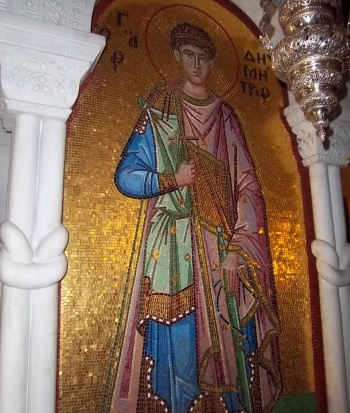
According to tradition, while being in prison, he blessed his disciple Nestor “sealing his forehead with the cross”, so that he will be able to defeat the pagan arrogant wrestler Lyaeus. Nestor’s victory enraged co-emperor Maximian, who happened to be in the stadium during the wrestling and commanded Nestor’s beheading, while Demetrios was killed by lancing of his side.
Saints Eustathius of Thessalonica and Gregory Palamas, as well as Demetrios Chrysoloras, authored eulogies for the Saint, where they mention that his body was buried in the place of his martyrdom, while his tomb was transformed into a deep well gushing myrrh, whence the title Myrrh-gusher came from.
In Byzantine icons, as well as the modern iconography, Saint Demetrios is often depicted as a rider on a red horse, in contrast to Saint George’s white horse, stepping on infidel Lyaeus. The patron saint of Thessaloniki is celebrated on October 26.
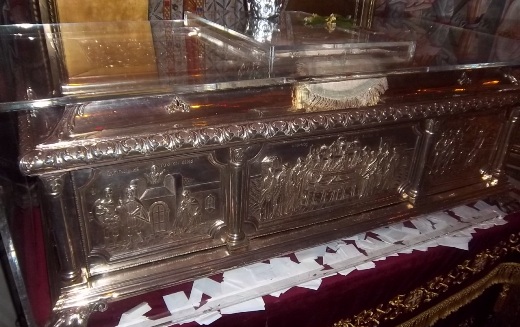
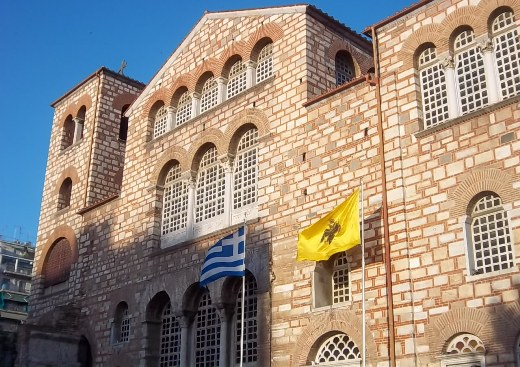

Tel.: (+30) 2310270008
Source: http://www.inad.gr/ Webpage of Saint Demetrius Pilgrimage Church



